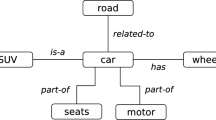Abstract
Within the general enterprise of probing into the complexities of lexical knowledge, one particularly promising research focus is on word association knowledge. Given Deese’s [1] and Cramer’s [2] convictions that word association closely mirror the structured patterns of relations that exist among concepts, as largely echoed Hirst’s [3] more recent comments about the close relationships between lexicons and ontologies, as well as Firth’s [4] remarks about finding a word’s meaning in the company it keeps, efforts to capture and unravel the rich networks of associations that connect words together are likely to yield interesting insights into the nature of lexical knowledge. Adopting such an approach, this paper applies a range of network analysis techniques in order to investigate the characteristics of network representations of word association knowledge in Japanese. Specifically, two separate association networks are constructed from two different large-scale databases of Japanese word associations: the Associative Concept Dictionary (ACD) by Okamoto and Ishizaki [5] and the Japanese Word Association Database (JWAD) by Joyce [6] [7] [8]. Results of basic statistical analyses of the association networks indicate that both are scale-free with small-world properties and that both exhibit hierarchical organization. As effective methods of discerning associative structures with networks, some graph clustering algorithms are also applied. In addition to the basic Markov Clustering algorithm proposed by van Dongen [9], the present study also employs a recently proposed combination of the enhanced Recurrent Markov Cluster algorithm (RMCL) [10] with an index of modularity [11]. Clustering results show that the RMCL and modularity combination provides effective control over cluster sizes. The results also demonstrate the effectiveness of graph clustering approaches to capturing the structures within large-scale association knowledge resources, such as the two constructed networks of Japanese word associations.
Access this chapter
Tax calculation will be finalised at checkout
Purchases are for personal use only
Preview
Unable to display preview. Download preview PDF.
Similar content being viewed by others
References
Deese, J.: The Structure of Associations in Language and Thought. The John Hopkins Press, Baltimore (1965)
Cramer, P.: Word Association. Academic Press, New York & London (1968)
Hirst, G.: Ontology and the Lexicon. In: Staab, S., Studer, R. (eds.) Handbook of Ontologies, pp. 209–229. Springer, Heidelberg (2004)
Firth, J.R.: Selected Papers of J. R. Firth 1952-1959. In: Palmer, F.R. (ed.), Longman, London (1957/1968)
Okamoto, J., Ishizaki, S.: Associative Concept Dictionary and its Comparison with Electronic Concept Dictionaries. In: PACLING 2001, pp. 214–220 (2001)
Joyce, T.: Constructing a Large-scale Database of Japanese Word Associations. In: Tamaoka, K. (ed.) Corpus Studies on Japanese Kanji (Glottometrics 10), pp. 82–98. Hituzi Syobo, Tokyo, Japan and RAM-Verlag, Lüdenschied, Germany (2005)
Joyce, T.: Mapping Word Knowledge in Japanese: Constructing and Utilizing a Large-scale Database of Japanese Word Associations. In: LKR 2006, pp. 155–158 (2006)
Joyce, T.: Mapping Word Knowledge in Japanese: Coding Japanese Word Associations. In: LKR 2007, pp. 233–238 (2007)
van Dongen, S.: Graph Clustering by Flow Simulation. Ph.D. thesis, University of Utrecht (2000)
Jung, J., Miyake, M., Akama, H.: Recurrent Markov Cluster (RMCL) Algorithm for the Refinement of the Semantic Network. In: LREC2006, pp. 1428–1432 (2006)
Newman, M.E., Girvan, M.: Finding and Evaluating Community Structure in Networks. Phys. Rev. E69, 026113 (2004)
Church, K.W., Hanks, P.: Word Association Norms, Mutual Information, and Lexicography. Comp. Ling. 16, 22–29 (1990)
Dorow, B., et al.: Using Curvature and Markov Clustering in Graphs for Lexical Acquisition and Word Sense Discrimination. In: MEANING-2005 (2005)
Steyvers, M., Shiffrin, R.M., Nelson, D.L.: Word Association Spaces for Predicting Semantic Similarity Effects in Episodic Memory. In: Healy, A.F. (ed.) Experimental Cognitive Psychology and its Applications (Decade of Behavior), Washington, DC, APA (2004)
Steyvers, M., Tenenbaum, J.B.: The Large-Scale Structure of Semantic Networks: Statistical Analyses and a Model of Semantic Growth. Cog. Sci. 29, 41–78 (2005)
Nelson, D.L., McEvoy, C., Schreiber, T.A.: The University of South Florida Word Association, Rhyme, and Word Fragment Norms (1998), http://www.usf.edu/FreeAssociation
Fellbaum, C. (ed.): WordNet: An Electronic Lexical Database. MIT Press, Cambridge (1998)
Roget, P.M.: Roget’s Thesaurus of English Words and Phrases (1991), http://www.gutenberg.org/etext/10681
Moss, H., Older, L.: Birkbeck Word Association Norms. Psychological Press, Hove (1996)
Umemoto, T.: Table of Association Norms: Based on the Free Associations of 1,000 University Students (in Japanese). Tokyo, Tokyo Daigaku Shuppankai (1969)
Version 1 of the JWAD, http://www.valdes.titech.ac.jp/~terry/jwad.html
Barabasi, A.L., Albert, R.: Emergence of Scaling in Random Networks. Science 286, 509–512 (1999)
Watts, D., Strogatz, S.: Collective Dynamics of ‘Small-world’ Networks. Nature 393, 440–442 (1998)
Ravasz, E., Barabasi, A.L.: Hierarchical Organization in Complex Networks. Physical Rev. E 67, 26112 (2003)
Dorogovtsev, S.N., Goltsev, A.V., Mendes, J.F.F.: Pseudofractal Scale-free Web, e-Print Cond-Mat/0112143 (2001)
Vechthomova, O., et al.: Synonym Dictionary Improvement through Markov Clustering and Clustering Stability. In: International Symposium on Applied Stochastic Models and Data Analysis, pp. 106–113 (2005)
RMCLNet, http://perrier.dp.hum.titech.ac.jp/semnet/RmclNet/index.jsp
Widdows, D., Cederberg, S., Dorow, B.: Visualisation Techniques for Analyzing Meaning. TSD5, 107–115 (2002)
Author information
Authors and Affiliations
Editor information
Rights and permissions
Copyright information
© 2008 Springer-Verlag Berlin Heidelberg
About this paper
Cite this paper
Joyce, T., Miyake, M. (2008). Capturing the Structures in Association Knowledge: Application of Network Analyses to Large-Scale Databases of Japanese Word Associations. In: Tokunaga, T., Ortega, A. (eds) Large-Scale Knowledge Resources. Construction and Application. LKR 2008. Lecture Notes in Computer Science(), vol 4938. Springer, Berlin, Heidelberg. https://doi.org/10.1007/978-3-540-78159-2_12
Download citation
DOI: https://doi.org/10.1007/978-3-540-78159-2_12
Publisher Name: Springer, Berlin, Heidelberg
Print ISBN: 978-3-540-78158-5
Online ISBN: 978-3-540-78159-2
eBook Packages: Computer ScienceComputer Science (R0)




